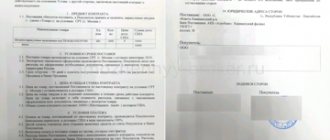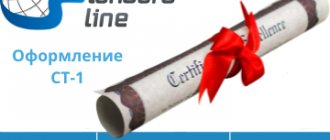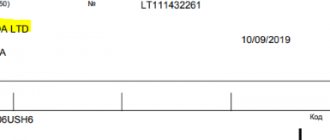Hello, dear colleague! In today's article we will talk about the declaration of the country of origin of goods when participating in procurement within the framework of 44-FZ. Such a declaration is necessary if the Customer, during the procurement, has established conditions for admission, restrictions on the admission of goods originating from a foreign state or a group of foreign states (Article 14 44-FZ “national treatment” and Order of the Ministry of Finance of Russia No. 126n dated 04.06.2018 .). The national regime was introduced at the legislative level to create advantages for manufacturers from the EAEU countries (Russia, Belarus, Armenia, Kazakhstan, Kyrgyzstan). In this article we will look in detail at what documents allow you to confirm the country of origin of goods (CPO) and where to get them.
Country of origin of goods
The country of origin of a product is the country where the product was entirely produced or subjected to significant processing or processing in accordance with established criteria (sufficient processing criteria).
The country of origin of the goods can be confirmed by the following documents:
- Certificate of origin of goods ST-1. This is a document confirming the fact of production of goods in the exporting country and is issued by the authorized bodies of that country. In our country, the CT-1 certificate is issued by the Chamber of Commerce and Industry or one of its regional divisions.
- Declaration of the country of origin of the goods. Such a declaration is a statement made by the manufacturer of the product, seller or other person who ships it from the country of origin. The application contains information on the basis of which it is possible to determine in which country the product was produced.
Submission of documents
A certificate or declaration is provided to obtain tariff preferences. Of course, in the event that the Customs Union gives these same preferences to the state where the products were manufactured. In this case, the documents must be submitted along with the customs declaration.
In addition, a document confirming the country of origin of the goods may be requested by customs officers if the information specified in the customs declaration is found to be unreliable. Despite the fact that this information affects the amount of customs duties or other taxes.
In the following cases, you will not need to confirm the origin of the goods and present a certificate or declaration:
- when moving goods across the border by individuals;
- when transiting goods through customs territory with exemption from duties and taxes (except for cases where customs officers discovered that the goods were imported from the territory of a country from which import is prohibited);
- if the cost of imported goods is less than a certain amount established by the Customs Union Commission;
- in some other cases provided for by the legislation of the Customs Union.
Samples of declarations of the country of origin of goods for legal entities and individual entrepreneurs
The SPT declaration for participation in procurement under 44-FZ is prepared very simply and is a document prepared on the procurement participant’s letterhead.
If you are an individual entrepreneur, then you can do without a letterhead. The declaration consists of the following required attributes:
- A header indicating the “Declaration of the country of origin of the goods offered for delivery”;
- Text block with the following content: “For the purpose of executing clause 6, part 5, art. 66, part 4 of article 14 of the Federal Law of 04/05/2013 No. 44-FZ “On the contract system in the field of procurement of goods, works, services to meet state and municipal needs”, Order of the Ministry of Economic Development of Russia of 03/25/2014 No. 155.
- A table consisting of three columns: item number, name of the product and name of the country of origin of the product. In this table, the participant declares the SPT of the goods proposed for delivery.
- Position, full name, signature, seal (if available).
You can download ready-made samples of SPT declarations below:
Sample declaration for individual entrepreneurs -
Sample declaration for a legal entity -
Documents Statistics on documents and execution of orders
GOVERNMENT OF THE RUSSIAN FEDERATION
ORDER
dated June 16, 2021 No. 1618-r
MOSCOW
On the signing of the Protocol between the Government of the Russian Federation and the Government of the Azerbaijan Republic on the mutual use of electronic systems for certification of the origin of goods
In accordance with paragraph 1 of Article 11 of the Federal Law “On International Treaties of the Russian Federation”, approve the draft Protocol between the Government of the Russian Federation and the Government of the Azerbaijan Republic on mutual application, submitted by the Ministry of Finance of Russia and other interested federal executive authorities and previously worked out with the Azerbaijani Side electronic systems for certification of the origin of goods (attached).
Instruct the Federal Customs Service of Russia to conduct negotiations with the Azerbaijani Party and, upon reaching an agreement, sign the said Protocol on behalf of the Government of the Russian Federation, allowing, if necessary, to make changes to the attached draft that are not of a fundamental nature.
Chairman of the Government of the Russian Federation M. Mishustin
Project
PROTOCOL between the Government of the Russian Federation and the Government of the Azerbaijan Republic on the mutual use of electronic systems for certification of the origin of goods
The Government of the Russian Federation and the Government of the Azerbaijan Republic, hereinafter referred to as the Parties,
taking into account the provisions of the Agreement on the Rules for Determining the Country of Origin of Goods in the Commonwealth of Independent States of November 20, 2009 (hereinafter referred to as the Rules),
seeking to increase the level of cooperation in order to protect the economic and public interests of the states of the Parties,
Recognizing that the mutual use of electronic systems for certification of the origin of goods will ensure increased efficiency of customs control, acceleration of customs operations (customs clearance), facilitation of mutual trade and accurate calculation of customs duties, taxes and other payments,
have agreed as follows:
Article 1
Definitions
The terms used in this Protocol mean the following:
a) “verification” - establishing the fact of issuing certificates of origin of goods in the form “ST-1” by authorized bodies (organizations) of the states of the Parties and the correctness of their completion in accordance with the requirements of the Rules;
b) “customs service”:
in the Russian Federation - Federal Customs Service;
in the Azerbaijan Republic - the State Customs Committee of the Azerbaijan Republic;
c) “central authorized body (organization)”:
in the Russian Federation - the Chamber of Commerce and Industry of the Russian Federation;
in the Azerbaijan Republic - State Service for Antimonopoly and Consumer Market Control under the Ministry of Economy of the Azerbaijan Republic;
d) “authorized body (organization)”:
in the Russian Federation - chambers of commerce and industry that issue certificates of goods passing the form “ST-1”;
in the Republic of Azerbaijan - territorial divisions of the State Service for Antimonopoly and Consumer Market Control under the Ministry of Economy of the Azerbaijan Republic, issuing certificates of goods passing the form “ST-1”;
e) “electronic system for certification of the origin of goods” - an information system of a central authorized body (organization), including information databases of electronic forms of certificates of origin of goods of the “ST-1” form, issued by authorized bodies (organizations) of the States of the Parties (hereinafter referred to as the electronic certification system ).
Article 2
General provisions
Electronic certification systems are created in order to ensure that the customs authority of the country of import can verify the fact of issuance of the certificate of origin of goods in the form “ST-1”, information about which is declared during the customs declaration, and the correctness of its completion without the need to present the specified certificate in the original on paper.
The use of an electronic certification system will ensure the acceleration of verification procedures (inspections) of certificates of origin of goods of the form “ST-1” issued by the authorized bodies of the country of export.
Article 3
Subject and scope of this Protocol
1. The central authorized body (organization) places in the electronic certification system created and regulated by it information about certificates of origin of goods of the form “ST-1” issued in the state of its Party.
2. The central authorized body (organization) of the country of export of goods sends the information contained in the electronic form of the certificate of origin of goods, form “ST-1”, within the framework of the electronic certification system to the customs service of the country of import of goods.
Customs services use the information received within the framework of the electronic certification system to verify certificates of origin of goods of the form “ST-1”, information about which is submitted to the customs authorities of the States of the Parties during the customs declaration of goods originating from the territories of the States of the Parties.
Article 4
Basic principles of creating and using an electronic certification system
The basic principles of creating and applying an electronic certification system are:
a) centralization of the collection of information on certificates of origin of goods of the form “ST-1” issued by authorized bodies (organizations);
b) the relevance and reliability of the information contained in the electronic certification system about issued certificates of origin of goods of the “ST-1” form;
c) excluding the possibility of unauthorized distortion or destruction of information contained in the electronic certification system;
d) ensuring storage of electronic forms of certificates of origin of goods of the form “ST-1” in the electronic certification system for at least 3 years from the date of their issue.
Article 5
Requirements for information exchange
1. The composition of the information contained in the electronic form of the certificate of origin of goods of form "ST-1", entered into the electronic certification system, must be identical to the composition of the information contained in the certificate of origin of goods of form "ST-1", issued to the applicant in the original on on paper, and comply with the requirements and procedure for filling out the certificate of origin of goods of the form "ST-1", set out in the Rules, with the exception of signatures and seals affixed to the original certificate of origin of goods of the form "ST-1".
2. The electronic form of the certificate of origin of goods, form "ST-1", is entered into the electronic certification system no later than one day following the day of certification by the relevant authorized body (organization) of the original certificate of origin of goods, form "ST-1", issued on paper. in the manner prescribed by the Rules.
3. The composition of information from the certificate of origin of goods of the form “ST-1”, transmitted during the implementation of electronic information exchange, and the scheme for organizing information interaction within the framework of the electronic certification system are given in Appendices No. 1 and 2.
Customs services and central authorized bodies (organizations), in order to implement the exchange of information contained in the electronic form of the certificate of origin of goods of the “ST-1” form, within 6 months from the date of entry into force of this Protocol, agree on the procedure for transferring information, the structure and format of the transferred data, information protection requirements and approve technical conditions for information interaction.
Article 6
Operation of the electronic certification system
1. The central authorized body (organization) provides:
a) completeness, relevance and reliability of the information contained in the electronic certification system on certificates of origin of goods of the form “ST-1” issued by the authorized bodies (organizations) of the state of its Party;
b) protection of information contained in the electronic certification system from unauthorized access, destruction, modification, blocking, and other unlawful actions;
c) proper round-the-clock functioning of the electronic certification system.
2. In case of improper functioning of the electronic certification system, the general provisions of the Rules apply regarding documentary confirmation of the country of origin of goods.
Article 7
Verification procedure
1. If it is established that the information provided during the customs declaration of goods on the certificates of origin of goods of the form “ST-1” issued by the authorized body (organization) of the country of export is not available in the electronic certification system or the information provided during the customs declaration of goods does not correspond to the information contained in the electronic certification system, the customs authorities of the country of import of goods carry out an inspection in the manner prescribed by the Rules.
2. If one of the customs services of the states of the Parties identifies signs indicating that the declared information about the country of origin of goods may be unreliable or not properly confirmed, the original certificate of origin of goods form “ST-1” on paper must be presented at the request of the customs authority of the country of import of goods.
3. The presence of errors (typographical errors) made when filling out the certificate of origin of goods of the form “ST-1”, which do not affect the reliability of the information contained in such a certificate, should not be grounds for refusal to grant a free trade regime.
Article 8
Test trials
1. Central authorized bodies (organizations) and customs services, after signing the technical conditions for information interaction to test the information exchange technology, carry out test tests, during which the customs services, for the purpose of providing a free trade regime in relation to goods originating from the territory of the States of the Parties, require documentary confirmation of the origin of goods in accordance with the provisions of the Rules.
The test period is 3 months. This period, if necessary, can be extended by agreement between central authorized bodies (organizations) and customs services.
2. Upon completion of the testing, the central authorized bodies (organizations) and customs services agree on the date for the beginning of the exchange of information on a regular basis.
After 15 days from the date of the beginning of the exchange of information on a regular basis, the customs service of the country of import of goods should not require the submission of documentary evidence of the origin of goods from the territories of the states of the Parties for the purpose of granting a free trade regime, except for the cases specified in paragraph 2 of Article 6 and Article 7 of this Protocol .
Article 9
Application of the Protocol
This Protocol cannot limit the powers of the customs authorities of the States of the Parties to verify the authenticity of documents presented by the person declaring goods in order to determine the country of origin of the goods and the reliability of the information contained therein in the manner prescribed by the customs legislation of the country of import.
Article 10
Settlement of disputes and disagreements
Disputes and disagreements between the Parties related to the application or interpretation of the provisions of this Protocol are resolved through consultations and negotiations between them.
Article 11
Changes and additions
This Protocol, by agreement of the Parties, may be amended and supplemented, which are an integral part of it, drawn up in separate protocols, which come into force in the manner established by Article 12 of this Protocol.
Article 12
Final provisions
This Protocol comes into force on the date of receipt through diplomatic channels of the last written notification confirming that the Parties have completed the internal procedures necessary for its entry into force.
This Protocol is concluded for an indefinite period. Either Party may terminate it by written notice sent to the other Party through diplomatic channels. In this case, this Protocol shall terminate 3 months from the date of receipt by the other Party of the relevant notification.
Done in » » 20 in two copies, each in Russian and Azerbaijani languages, both texts being equally authentic.
| For the Government of the Russian Federation | For the Government of the Azerbaijan Republic |
________________
APPENDIX No. 1 to the Protocol between the Government of the Russian Federation and the Government of the Azerbaijan Republic on the mutual use of electronic systems for certification of the origin of goods
COMPOSITION OF INFORMATION from the certificate of origin of goods of the form “ST-1”, transmitted during the implementation of electronic information exchange within the framework of the electronic certification system
To indicate the multiplicity, mandatory completion and number of possible repetitions of transmitted information in tables 1 - 6 in the “Note” column, the following notations are used:
1 - information must be filled in, repetitions are not allowed;
1..* - information must be filled in and can be repeated without restrictions;
0..1 — information is optional, repetitions are not allowed;
0..* — information is optional and can be repeated without restrictions.
Table 1
No. | Name of information | Description | Note |
1. | Code designation of the form of the certificate of origin of goods | the code “ST-1” is indicated | 1 |
2. | Additional code designation | a code indicating the following is indicated: the issued certificate of origin of goods of the form “ST-1” is the original; the issued certificate of origin of goods of the form “ST-1” is a duplicate of the certificate of origin of goods of form “ST-1”; the issued certificate of origin of goods in the form “ST-1” is a replacement for the original certificate of origin of goods in the form “ST-1”; the issued certificate of origin of the goods was canceled | 1 |
3. | Information about the certificate of origin of goods, form “ST-1” | information is indicated in accordance with the list presented in Table 2 of this appendix | 1 |
4. | Information about the country that issued the certificate of origin of goods, form “ST-1” | indicate the code and name of the country in which the certificate of origin of the goods of the form “ST-1” was issued | 1 |
5. | Information about the country for which the certificate of origin of goods in the form “ST-1” was issued | indicate the code and name of the country for which the issued certificate of origin of goods of the form “ST-1” is intended | 1 |
6. | Date of cancellation of the certificate of origin of goods form “ST-1” | if necessary, indicate the date of cancellation (revocation) of the certificate of origin of goods, form “ST-1” | 0..1 |
7. | Date of amendments to the certificate of origin of goods, form “ST-1” | if necessary, indicate the date of amendments to the certificate of origin of goods in the form “ST-1” | 0..1 |
8. | Code designation of the category of the certificate of origin of goods of the form “ST-1” | if necessary, official marks are indicated indicating that the certificate of origin of goods of the form “ST-1” was issued subsequently (if the certificate of origin of goods of the form “ST-1” was not issued before or during the export of the goods), issued as a replacement or a duplicate (column 5) | 0..1 |
9. | Information about a previously issued certificate of origin of goods, form “ST-1” | information is indicated (including the registration number and date of issue of such a certificate) about the previously issued certificate of origin of goods of the form “ST-1” in accordance with the list presented in Table 2 of this appendix, if the certificate of origin of goods of the form “ST-1” is a duplicate or in case of replacement of the original certificate of origin of goods of the form “ST-1” | 0..* |
10. | Country of origin information | indicate the code and name of the country of origin of the goods (CIS member states) | 1 |
11. | Information about the authorized body | contains information about the authorized body (organization) that issued the certificate of origin of goods of the form “ST-1”, including the name of the authorized body (organization) | 1 |
12. | Information about the certification of the certificate of origin of goods, form “ST-1” | information about the official of the authorized body (organization) and the place of certification of the certificate of origin of goods in the form “ST-1” is indicated | 1 |
13. | Information about the applicant | information about the place and date of application of information, as well as information about the applicant, is indicated | 1 |
14. | Information about the consignment | contains information in accordance with the list presented in Table 3 of this appendix | 1 |
15. | Date and time when information was recorded in the database | date and time of registration of information from the certificate of origin of goods of the form “ST-1” in the database of certificates of origin of goods of the form “ST-1” | 1 |
table 2
List of information about the document
| No. | Name of information | Description | Note |
| 1. | Registration number of the certificate of origin of goods, form “ST-1” | indicate the registration number of the certificate of origin of the goods, form “ST-1” | 1 |
| 2. | Date of issue of the certificate of origin of goods, form “ST-1” | the date of issue of the certificate of origin of the goods in the form “ST-1” is indicated | 1 |
Table 3
List of information about the consignment
Item no. | Name of information | Description | Note |
1. | Shipper/exporter (name and address) | information about the shipper/exporter of the goods is indicated. If the shipper and exporter are different legal entities, it should be indicated that the shipper (name and address) acts “on behalf of” the exporter (name and address) | 1 |
2. | Consignee/importer (name and address) | information about the consignee/importer of the goods is indicated. If the consignee and the importer are different legal entities, it should be indicated that the consignee (name and address) acts “on behalf of” the importer (name and address) | 1 |
3. | Means of transport and route (as far as known) | means of transport are indicated |
Is a declaration necessary or is it enough to simply indicate the country of origin of the goods?
In accordance with paragraphs.
“h” clause 1, part 2, article 51, clause 6, part 5, article 66, clause 6, part 3, article 73, the procurement participant in the application must provide documents confirming the compliance of the procurement participant and (or) the proposed them of goods, work or services, conditions, prohibitions and restrictions established by the Customer in accordance with Article 14 of 44-FZ, or copies of these documents (in tenders and requests for quotations - certified copies of these documents). In accordance with paragraph 1 of paragraph 13 of Order No. 155, confirmation of the country of origin of the goods specified in the list attached to Order No. 155 is the declaration of the procurement participant.
However, paragraph 2 of paragraph 13 of Order No. 155 also states that if a procurement participant does not submit a corresponding declaration, the provisions of this order (i.e. preferences) simply do not apply to such participant.
The Ministry of Economic Development, in its letter dated December 14, 2016 No. D28i-3279 “On the application of Order of the Ministry of Economic Development of Russia dated March 25, 2015 N 155,” is of the opinion that declaring the country of origin of a product is an indication of this country in the participant’s application. And even if there is no declaration in the form of a separate document, such an application complies with the requirements of 44-FZ and cannot be rejected.
But this is just the position of the MER. Many territorial bodies of the FAS have the opposite opinion, so it is better that this document be part of your application.
Changes in the declaration of SPT from 07/01/2018
From July 1, 2021, amendments made in December 2021 by Federal Law No. 504-FZ come into force in 44-FZ.
According to these amendments, if a participant’s application does not contain the documents provided for by regulatory legal acts adopted in accordance with Article 14 44-FZ, then such an application will be equated to an application that contains an offer to supply goods originating from a foreign state or group foreign states, works, services, respectively, performed and provided by foreign persons. Thus, the participant will lose the corresponding preferences, but his application will not be rejected.
The application will be rejected only if an explicit prohibition is established in relation to the purchased goods, works, services, as provided for in Article 14 44-FZ.
You can read more about the amendments to 44-FZ in our article - Changes to 44-FZ - as amended from July 1, 2021.









